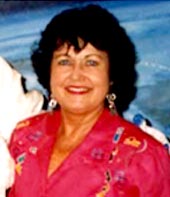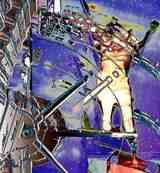|
Cecil Herring
–
painter and sculptor
|

|
"
discipline is the most important quality an artist can have...
" |

|
| |
|
|
|
| |
How were you motivated to choose your particular field? |
| |
I have trekked down many blind alleys, tried many technologies for my
space art. Welding, electroforming, spraying vinyls, painting, recycling
space junk, casting plastics. I have experimented for decades. I never
quite understood my drive until now, as we approach the Millenium,
plan space colonies and stations. The puzzle comes together in a magical
way!
My early memories are my Father, Cecil J. Darby, pointing out
constellations and stars to me, reading Edgar Rice Burroughs' A Princess
of Mars, The Chessman of Mars for bedtime stories! He would point to
Mars and say, "See that red star? We'll go there someday." I remember
thinking of the colors, strange shapes and having vivid dreams every
night!
I'm sure I got my love of space and space art from him. He was a
dreamer with a car garage, welded and built racecars. We went everywhere.
Pan American World Airways Clipper Ships took off from Dinner Key in
Miami, my home town. We watched the big planes taxi out on Biscayne Bay
and takeoff. We went to air shows where planes did loop–t–loops and dives
all over the place. Somehow it all got jumbled together – my passions for
art, metals, space and technology. I studied art and breathlessly watched
the space launches on TV.
In 1965, we moved to Brevard County where there were weekly launches.
By 1967, I was a space writer - photographer for the local paper. Then, I
got to watch every awesome launch from a press site three miles away. I
got to meet astronauts, Dr. Wernher von Braun, and climb around in the
Vehicle Assembly Building. Press and famous people were everywhere. We all
had stars in our eyes! It had a huge impact on my art forms!
I began welding steel and 'space junk' armatures I got from area
junkyards and sprayed polyvinyl chloride (a material used to mothball
Navalfleets) over the welded armatures. I added electrical wiring so they
would light up! That is how my Spacescapes© came to be. They are
lightweight, other worldly, holey, curvilinear shapes, covered with a
spanable cobweb material, built up into a durable hidelike covering. Using
a diesel compressor and a pressurized spray system sprayed the
molasses–like liquid that floated over the armatures, leaving holes. I
painted them in swirling day–glo colors.
Some had black-lights blinking and some included moving parts.
Naturally, they all had space–related names like Crater Craft, Cool It
Charley – A Lunar Experiment, Take Me to Your Leader. They were shown
in black rooms, illuminated with a pulsing black light system I
synchronized with synthesizer music of eery screams. roars and thumps –
sounds of outer space They glowed in the dark! They were a hit at my
one–woman show in New York in 1971. I called the show Spacescapes©. I was
even invited to be on ABC Eyewitness News Channel 9 there in New York
City.
For 30 years, I've kept the name and spacey imagery going through some
tough times. I don't weld or use metal–forming methods now. I got very
sick in the early 80s with metal poisoning. My lungs were black. Give it
ALL up or die, several doctors said. I thought I was through as an artist.
All metals, solvents, chemicals, plastics, even oil paints became toxic
tome. I thought I was through as an artist so I went to college, EVEN LAW
SCHOOL! That was a 10–year down period in my life! I was glad the Digital
Art Age came around in the late 80s, just in the nick of time for me! It
is cleaner and safer, believe me. Now, I recreate three dimensional art
works in a two dimensional medium, using many of those old space images I
stored on CD Roms!
|
|

|
| |
|
|
|
| |
What can you share about your creative process? |
| |

|
|
I am at the process of making art all the time, refueling my visual
tanks with movies, trips to museums, circuses, shows, theme parks, the
Space Center, real action stuff. Then I dream a bit in my orchid garden,
play loud classical music, make paintings or drawings for practice works
or try new digital techniques, doing things a little differently each
time.
I may print a digital print of a new work. Then, I laminate it to a
gessoed masonite board and apply layers of special ultraviolet inhibiting
varnish (important to reduce fading), embedding computer-generated
transparencies (printed on transparency film) in the varnish. Then, I
cover the work with plexiglass, painted on the inside with enamels, plus
brilliant stain glass glazes. I frame the layers together. This will give
me my favorite effect of seeing images through colors, or iridescent
stained-glass effects. Sometimes these techniques are modified, with
additions of metallic powders, cut stencils, sprayed straight lines and
areas in the plexiglass paper, or pieces of thin metal.
Or, I may paint a painting on canvas or watercolor paper and layer that
with the above techniques. I am able to print beautiful archival prints
using my big 36" printer, on canvas or watercolor paper. But I find a
greater challenge in making EACH work one-of-a-kind in some way. Spraying
the inks with water to get droplets and then over painting it with oil
paints. I want a work that SPEAKS TO ME every time I look at it.
Sometimes, that takes months. I rework endlessly, have huge failures. It's
difficult to say what I might try next. I DO TRY TO SHOW UP for my working
hours! I guess discipline is the most important quality an artist can have
and having the courage to change.
|
|
| |
|
|
|
| |
What ideas do you have for a future human community on Mars?
|
| |
It is one thing to make art on earth and quite another to actually have
'enduring' art on a distant planet. Shipping big sculptures or paintings
to Mars is impossible unless you can call the Internet a spaceshipping
service! But there IS a way to have ART on that distant Planet. God loves
artists! Soon after I began my digital art studies (1989) I heard about
the Internet. Art on–line became a reality. 1995, I got a web page and
started having 'conversations' with other artists in Hawaii, California
and Colorado, even South Africa! I made my own web site and started
'shipping' art 'files' around the globe or at least to a service bureau
for printing.
For art on a Mars Millennium Project, a file transfer protocol or other
derivative software easily could transport digital art to liquid crystal
display screens that show the latest 3D or other imagery, animations,
'still' art or perhaps manipulated photo images on colony walls. We
already have the technology. Using digital cameras, software programs, and
computers, we might have a digital art exchange program between Earth and
Mars. Some of the first Mars inhabitants might get homesick. We could beam
up a view of their favorite scenes.
Images may be created by the 'force' of the artist, by thought, touch
or voice. There are materials to be used on Mars – rocks for
lasercarvings, etchings, Mars Dust Art. Artists could collaborate, with
the entire space community networked and collectively creating. That is
called Renga, (Linked Images) similar to a Japanese form of poetry
collaboration or 'Linked Verse.' It creates a new image that has no
author.
I cannot imagine Martian colony art in the traditional 'enduring'
sense. The digital art world is electronic, not concrete. That's what
makes it so workable for a Martian Colony. Technologies we already have
are Caves– Virtual 3D environments. Sculptures would be perfectly 3D.
Virtual walking through art environments such as I designed 28 years ago
is completely possible and easily transportable! Once a base is
operational, technology no doubt will develop media to inspire permanent
works beyond our conception now. Remember – form follows function.
© 1999. Cecil Herring
|
|

|
|




